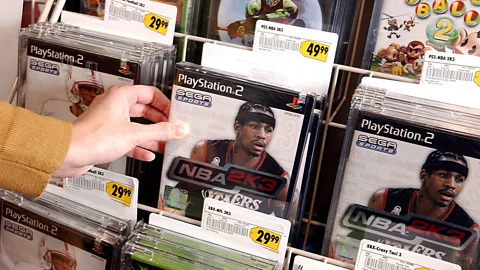The gaming industry is aiming for subscribers. Will gamers play along?
 Alamy
AlamyMedia ownership has increasingly diminished as music, television and film consumers have settled into streaming. As gaming subscriptions grow, a similar transition is inevitable.
In 2023, Netflix made a big push into the gaming sector, launching the first public tests of its cloud-streamed games to select consumers in Canada and the UK. This year, the streaming-media giant is doubling down on its move into the global gaming market, replicating the revolutionary business model that turned the film and television industries upside down. The long-anticipated move presents a major revenue opportunity to capitalise on the gaming world's increasing embrace of subscription services.
The writing has been on the wall since games started moving from physical to digital formats nearly two decades ago. Experts say it now seems all but inevitable that a subscription-based format will be the future of the world's most lucrative entertainment format – whether gamers are ready.
Netflix Games's suite of show-inspired games joins the playable offerings from fellow video streaming platforms, such as Apple Arcade and Amazon Luna. Meanwhile, each of the major gaming consoles now offer games bundled into a subscription package, such as PlayStation Plus, xBox Game Pass and Nintendo Switch Online. That's in addition to those offered by game developers themselves, including Ubisoft Plus and EA Play.
Gamers still pay top dollar to own hit games in either physical or digital formats. But in recent years, the industry has sought to monetise older or lesser-played titles by packaging them into bundles for a monthly fee. Though these services remain a small proportion of the industry's revenue, companies believe there is potential for growth and are aiming to grab an increasingly larger slice of the pie by going all-in on subscriptions.
Documents leaked from Microsoft in October 2022, for example, showed the Xbox maker believes it can reach 110 million Game Pass subscribers by 2030, up from an estimated 30 million today. Its recent $69bn (£54.4bn) takeover of Activison Blizzard could expedite that effort, as it brings some of the world's most popular gaming franchises – including Call of Duty – into their subscription line-up.
 Getty Images
Getty ImagesMany gamers are already in the streaming world, and plenty more are on their way. An October 2023 report from MiDIA Research, an entertainment-industry insights company, showed there were more than 180 million global game subscriptions active in 2023, up from about 171 million the year before. They project that number to reach 318.5 million by 2030.
"We've seen this huge transition in the games industry of moving away from the traditional, what I would call 'unit-sales-based' business model, towards an 'engagement-based' model," explains Karol Severin, MIDiA Research's senior games analyst and VP of data. "I would dare to say that the number of game subscriptions is going to grow much faster than the number of games sold for the next decade."
The new engagement model
The gaming industry is extremely lucrative. In 2023, subscription services brought in about $11.7bn (£9.2bn) and direct game sales brought in $40bn (£31.50bn). (For perspective, the entire music industry is valued at roughly $28bn [£22bn], while global box-office revenues totalled less than $34bn [£27bn] in 2023.)
One reason streaming subscriptions may represent a new revenue frontier is because of how gamers' relationships towards ownership is changing.
"The whole games industry used to be about buying games, or downloads – convincing customers that a game is good enough to buy as an individual unit," explains Severin. "You're seeing that model shift largely to being engagement-based, where the games are financially dependent on the amount of time consumers spend in those games, because they're increasingly monetised through in-game purchases."
While video game industry took in about $223bn (£175.5bn) overall in 2023, the majority of that profit didn't come from either subscriptions or direct sales. Instead, about $125bn (£98bn) was generated from in-game revenues, according to MIDiA, such as the sale of digital items including avatars, experience upgrades or shortcuts in gameplay as well as in-game ads and product placements.
This engagement model increasingly appears to be the future, says Severin. He adds the video game industry has become fully invested in the attention economy, and seeks to build out immersive experiences that encourage more engagement. That is now the primary driving force behind both video game design as well as distribution strategy.
"Now, we are seeing games developed with the aspiration of never being finished – it's not necessarily something to 'beat', but something to 'exist' in," he says. "Twenty, thirty years ago, defining one's image was about what clothes you wore, what music you listened to, where you worked and what car you had. Now we're spending so much time in the digital world that self-expression becomes part of people's digital lives."
The emphasis on engagement bodes well for subscription-model adoption, as game makers are incentivised to lower the barrier to entry as much as possible. That's why many of the world's most popular titles – including Fortnite, Roblox and League of Legends – are available for free. With the rise of subscription packages, gamers can also enjoy libraries full of games that used to cost $50 to $70 (£40 to £55) each for a monthly subscription of around $10 to $20 (£8 to £16).
As more gamers adopt subscription bundles, the model could also prove a huge boon to smaller and independent game developers. That's because, beyond the handful of hit games that arrive with dedicated fan bases and massive marketing campaigns, there's an entire ecosystem of indie developers that spend years and significant sums putting out a game with no guarantee of return.
 Alamy
Alamy"The games industry is hit-driven. A handful of titles make most of the money," says Joost van Dreunen, an adjunct assistant professor at NYU's Stern School of Business and author of One Up: Creativity, Competition, and the Global Business of Video Games. He explains that a subscription-based distribution model could offer those smaller developers a certain amount of guaranteed revenue, as well as the ability to reach a wider audience. "The promise of revenue from a subscription model is the antidote to a hit-driven machine."
Battling a 'tidal wave'
Subscriptions likely won't eliminate game ownership entirely – at least not yet.
Severin suggests consumers are still willing to shell out big bucks for top-tier games, which typically aren't included in subscription packages upon release. "Those that can hold out will for as long as they can, because the margins are favourable, but ultimately it's a tidal wave of a trend to battle against in the long-term."
Van Dreunen says he imagines a world where new consoles and hardware come with a one-year subscription to a gaming library, similar to how new televisions often come with streaming-media trials. He adds that while gamers of a certain age may struggle with the transition from ownership to subscriptions, the next cohort of gamers has a different perspective.
"As it becomes increasingly difficult for younger generations to own real things, we start to see a push towards temporary ownership, or renting, and that’s going to be the case at a high level, with fewer young families buying homes and cars," he says. "For younger generations ownership is not a necessity, and we’re going to also see that in the games industry."
